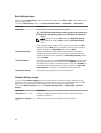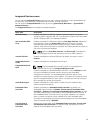
Menu Item Description
item in the boot order until the boot is successful
or no more boot options are found.
One Shot Boot Menu Takes you to the boot menu, where you can select
a one time boot device to boot from.
Launch System Setup Enables you to access System Setup.
Launch Lifecycle Controller Exits the Boot Manager and invokes the Lifecycle
Controller program.
System Utilities Launches System Utilities menu such as System
Diagnostics and UEFI shell.
Changing the boot order
You may have to change the boot order if you want to boot from a USB key or an optical drive. The
instructions given below may vary if you have selected BIOS for Boot Mode.
1. In the System Setup Main Menu, click System BIOS → Boot Settings.
2. Click Boot Option Settings → Boot Sequence.
3. Use the arrow keys to select a boot device, and use the <+> and <-> keys to move the device down
or up in the order.
4. Click Exit, click Yes to save the settings on exit.
Choosing the system boot mode
System Setup enables you to specify the boot mode for installing your operating system:
• BIOS boot mode (the default) is the standard BIOS-level boot interface.
• Unified Extensible Firmware Interface (UEFI) boot mode is an enhanced 64-bit boot interface. If you
have configured your system to boot to UEFI mode, it overlays the system BIOS.
To select the system Boot Mode:
1. In System Setup click Boot Settings and select Boot Mode.
2. Select the boot mode you want the system to boot into.
NOTE: After the system boots in the specified boot mode, proceed to install your operating system
from that mode.
CAUTION: Trying to boot the operating system from the other boot mode will cause the system
to halt at startup.
NOTE: Operating systems must be UEFI-compatible to be installed from the UEFI boot mode. DOS
and 32-bit operating systems do not support UEFI and can only be installed from the BIOS boot
mode.
NOTE: For the latest information on supported operating systems, go to dell.com/ossupport.
36


















